When you're looking for watches that hold their value, three luxury brands consistently lead the pack: Rolex, Patek Philippe, and Audemars Piguet. These manufacturers carefully control their production numbers and maintain exceptional quality standards, helping their timepieces retain or even increase in value by up to 15% annually. Rolex sets the industry standard with its timeless designs and durability, while Patek Philippe's limited production of about 50,000 pieces annually drives strong returns. Audemars Piguet, particularly its Royal Oak collection, can retain up to 90% of retail value. The secret to maximizing your watch's long-term value lies in understanding specific models and market dynamics.
Table of Contents
Understanding Watch Value Retention Factors
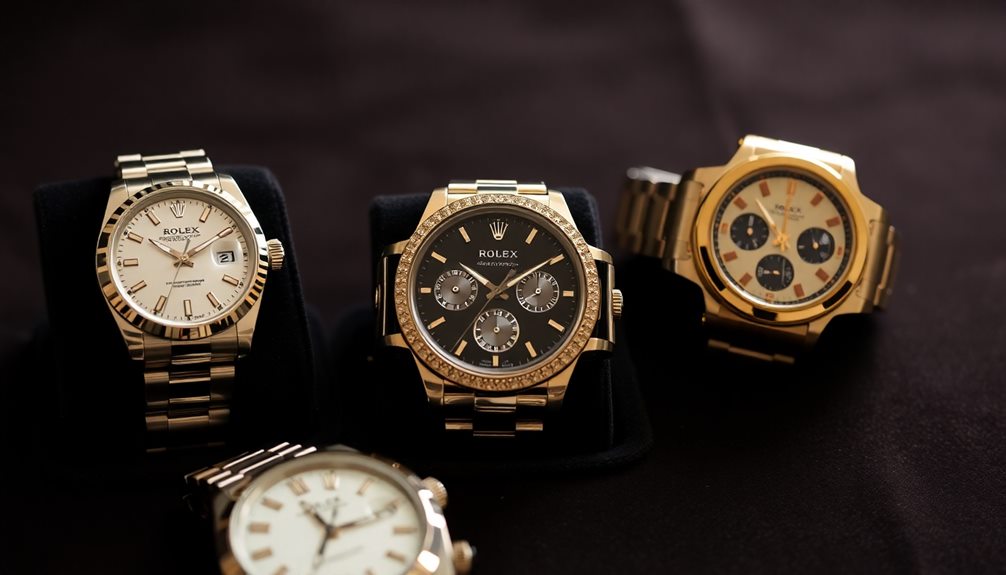
Watch value retention depends on several key factors that influence how well a timepiece maintains its worth over time.
Brand reputation plays an essential role, as prestigious manufacturers with long histories of excellence typically hold their value better than lesser-known brands. Limited production numbers also contribute considerably, since scarcity often drives up demand and preserves value.
Materials and craftsmanship matter tremendously in value retention. Watches made with precious metals like gold or platinum, and those featuring intricate complications, tend to maintain their worth better than simple stainless steel models.
The condition of your watch is equally important – regular maintenance, original packaging, and documentation all help preserve its value.
Market demand considerably impacts a watch's worth. Certain models become increasingly desirable due to celebrity associations, historical significance, or collector interest.
You'll find that discontinued models from prestigious brands often appreciate in value, especially if they've achieved iconic status.
Additionally, the authenticity factor can't be overlooked – watches from authorized dealers with verified service history typically retain value better than those with questionable provenance.
Rolex: The Gold Standard
When discussing value retention in luxury timepieces, Rolex stands as the benchmark against which all other brands are measured. The Swiss manufacturer's watches consistently maintain or increase their value, with some models appreciating greatly over time. You'll find that popular models like the Submariner, Daytona, and GMT-Master II often sell for well above their retail prices on the secondary market.
Rolex's value retention stems from several key factors. The brand maintains strict control over its production numbers, creating natural scarcity that drives demand. Their watches feature exceptional build quality, using corrosion-resistant 904L steel and proprietary materials that guarantee longevity.
You can also count on Rolex's timeless designs, which have remained largely unchanged for decades, contributing to their enduring appeal. The brand's marketing strategy and reputation for excellence have created a self-perpetuating cycle of desirability.
You'll notice that even during economic downturns, Rolex watches tend to hold their value better than other luxury items. If you're looking to invest in a timepiece that'll retain its worth, Rolex remains one of the safest choices in the luxury watch market.
Patek Philippe's Market Performance
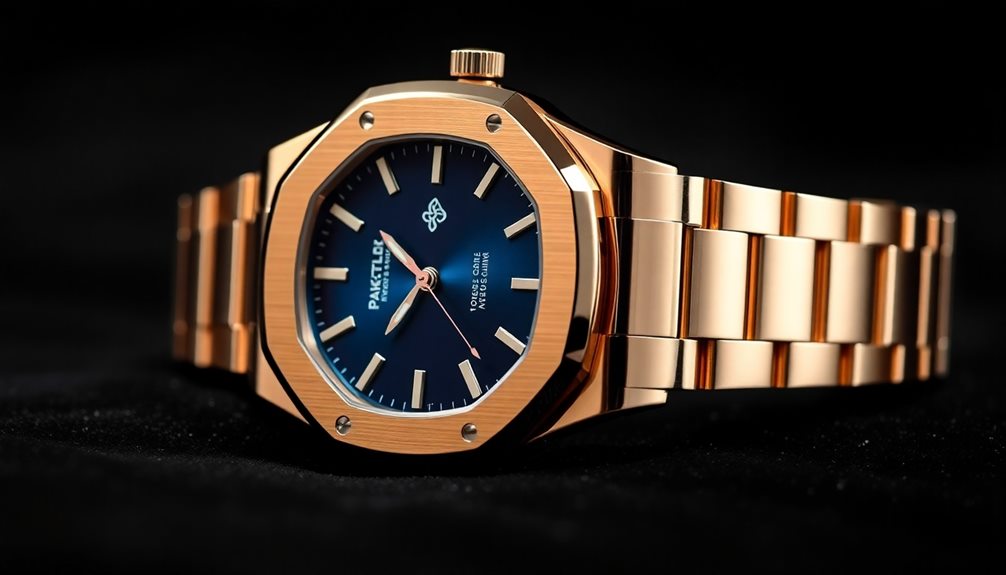
Surpassing even Rolex regarding value appreciation, Patek Philippe stands as the ultimate investment-grade watchmaker in the luxury timepiece market.
You'll find that certain Patek Philippe models have consistently achieved record-breaking auction prices, with vintage pieces regularly selling for millions of dollars. The brand's limited production numbers, typically around 50,000 pieces annually, help maintain their exceptional resale value.
The market performance of Patek Philippe watches is driven by several key factors:
- The brand's unmatched heritage since 1839 and their commitment to traditional watchmaking techniques make each piece highly desirable among collectors and investors.
- Their perpetual calendar complications and grand complications command premium prices, with models like the Nautilus and Calatrava leading the value retention charts.
- The extensive waiting lists for new models, sometimes extending beyond a decade, create immediate secondary market premiums.
You can expect a Patek Philippe timepiece to retain 80-100% of its original value, with many models appreciating considerably over time.
The most sought-after references, particularly from their Grand Complications collection, have shown average annual returns exceeding 15% over the past decade.
Audemars Piguet Investment Potential
Ranking among the top three Swiss luxury watchmakers, Audemars Piguet delivers impressive investment returns, particularly through its iconic Royal Oak collection. You'll find that Royal Oak models typically retain 85-90% of their retail value, with some limited editions appreciating by 200-300% within just a few years.
| Model | Avg. Retail Price | 5-Year Value Change |
|---|---|---|
| Royal Oak 15202ST | $35,000 | +155% |
| Royal Oak Offshore | $45,000 | +85% |
| Royal Oak Concept | $185,000 | +65% |
| Code 11.59 | $42,000 | +15% |
| Royal Oak Perpetual | $95,000 | +125% |
When you're considering an AP investment, focus on stainless steel Royal Oak models, which consistently outperform their precious metal counterparts. The brand's limited production of about 40,000 pieces annually helps maintain scarcity and value. You'll want to pay special attention to discontinued references, as they often experience significant price jumps. Keep in mind that condition and complete documentation are significant factors affecting resale value, so proper maintenance and careful storage of original papers and boxes is essential.
Omega's Long-Term Value Analysis
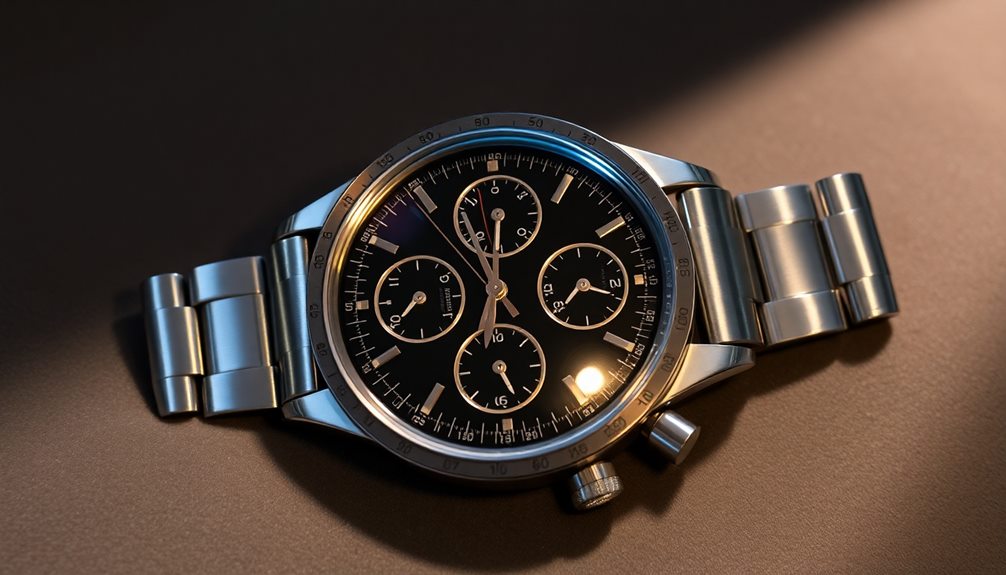
Omega consistently demonstrates strong value retention in the luxury watch market, though not quite matching the investment potential of Rolex or Audemars Piguet.
You'll find that certain Omega models, particularly the Speedmaster Professional "Moonwatch" and vintage Seamaster collections, maintain their worth exceptionally well. The brand's rich heritage, technical innovation, and significant role in space exploration contribute to its enduring appeal among collectors.
When analyzing Omega's long-term value proposition, consider these key factors:
- Limited editions and commemorative models typically appreciate faster than standard productions, with Apollo mission anniversary pieces showing particularly strong performance.
- Vintage Omega watches from the 1950s and 1960s have seen steady value increases, especially those with original parts and documented history.
- Modern Omega models incorporating Co-Axial movements and Master Chronometer certification tend to hold their value better than earlier iterations.
You should expect most new Omega watches to depreciate 20-30% in their first year, but well-maintained pieces often stabilize or appreciate gradually afterward.
The brand's continuous technological improvements and strategic limited releases help support long-term value retention.
Vintage Watch Market Dynamics
Over the past decade, the vintage watch market has experienced unprecedented growth and volatility, driven by increasing collector demand and social media influence.
You'll find that certain vintage models from prestigious brands like Rolex, Patek Philippe, and Audemars Piguet have seen their values skyrocket, particularly rare references with unique characteristics or historical significance.
When you're considering entering the vintage market, you'll need to understand that condition, originality, and provenance play vital roles in determining value.
Original parts, unpolished cases, and complete sets with boxes and papers command significant premiums.
You'll also notice that market trends can shift rapidly, with previously overlooked models suddenly becoming highly sought-after.
The vintage market's dynamics are heavily influenced by auction results, dealer networks, and online communities.
You'll find that platforms like Instagram and specialized watch forums have democratized information and accelerated price movements.
However, you should be aware that authenticity concerns and the prevalence of sophisticated counterfeits make expert authentication essential.
It's imperative to work with reputable dealers and thoroughly research any potential purchase in this complex market segment.
Limited Edition Timepiece Values
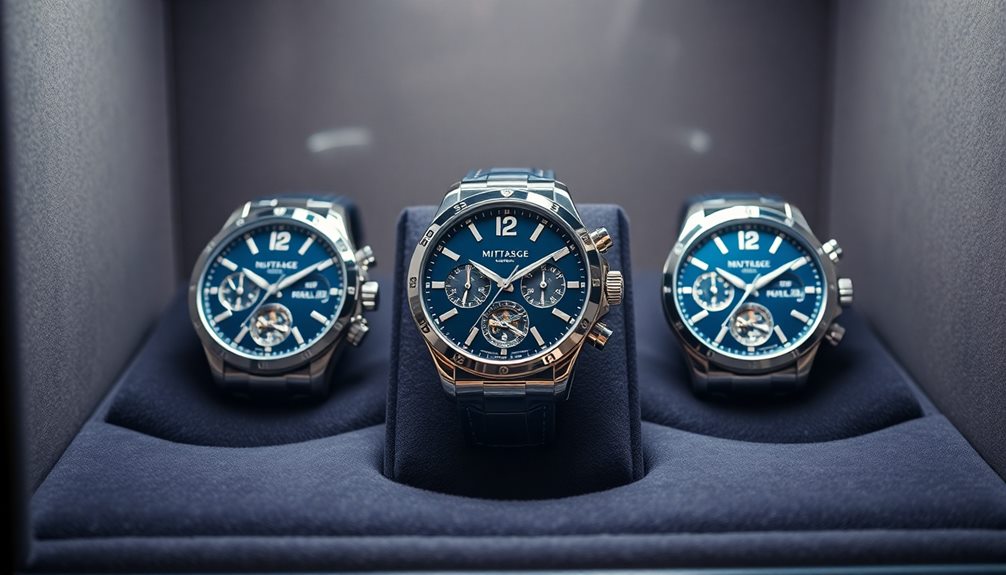
While mass-produced watches typically face steady depreciation, limited edition timepieces often command strong resale values due to their built-in scarcity and collector appeal.
You'll find that these special releases, particularly from prestigious brands like Patek Philippe and Audemars Piguet, can appreciate greatly over time when properly maintained and authenticated.
When you're considering limited edition watches as investments, focus on these key value drivers:
- Production Numbers – Watches with smaller production runs (typically under 1,000 pieces) tend to hold value better than those with larger runs, as they're inherently more difficult to acquire.
- Historical Significance – Commemorative editions marking important brand milestones or significant events often attract serious collectors and command premium prices.
- Unique Features – Special dial colors, exotic materials, or exclusive complications can greatly boost a timepiece's long-term value potential.
You'll want to maintain complete documentation, including certificates of authenticity and original packaging, as these elements directly impact resale value.
Keep in mind that market trends can shift quickly, so it's crucial to research current collector preferences and historical price patterns before making substantial investments in limited editions.
Best Entry-Level Investment Watches
For first-time watch investors, several Swiss and Japanese timepieces under $5,000 offer strong potential for value retention, including the Tudor Black Bay and the Grand Seiko SBGA211 "Snowflake."
You'll find that heritage models from established brands like Omega's Speedmaster Reduced and certain Longines chronographs combine historical significance with accessibility.
These entry-level investment pieces often serve as stepping stones to more prestigious collections while maintaining their own market appeal.
Popular Models Under ,000
Among the best entry-level investment watches under $5,000, several models stand out for their proven track record of value retention.
You'll find that certain timepieces in this price range consistently maintain their worth while offering excellent craftsmanship and brand heritage.
When you're looking to invest in a watch under $5,000, focus on established brands with strong resale markets. The Tudor Black Bay 58, priced around $4,300, delivers exceptional value with its vintage-inspired design and in-house movement.
Oris's Aquis Date, typically selling for $2,200, offers remarkable durability and distinctive styling that helps maintain its market position.
- Omega Seamaster Professional 300M (pre-owned) – These models often retain 80-85% of their value and can be found for under $5,000 in good condition.
- Longines Legend Diver – At approximately $2,400, it combines heritage design with modern reliability.
- TAG Heuer Carrera Calibre 5 – Available around $2,800, it represents a solid entry point into luxury watchmaking with strong brand recognition.
Focus on models with proven market performance, readily available parts, and established service networks to maximize your investment potential.
Heritage Pieces Worth Considering
Heritage timepieces represent the next step up from entry-level luxury watches, offering both historical significance and potential investment value. When you're considering heritage pieces, focus on iconic models from established manufacturers that have proven their staying power over decades.
The Omega Speedmaster Professional "Moonwatch" stands out as a prime example, with its NASA heritage and consistent design since the 1960s. You'll find that vintage models and modern iterations both maintain strong resale values.
Similarly, the IWC Pilot's Watch collection, particularly the Mark series, carries notable military aviation history and tends to appreciate over time.
Consider the Jaeger-LeCoultre Reverso, introduced in 1931, which combines unique design with practical functionality. Its art deco styling and innovative reversible case make it a sought-after collector's piece.
The Cartier Tank, worn by countless celebrities and leaders since 1917, remains a solid investment choice due to its timeless design and brand prestige.
For diving heritage, look at the Blancpain Fifty Fathoms, which pioneered modern dive watch features and consistently performs well in the secondary market. These watches typically start at $10,000 and can appreciate considerably with proper care and documentation.
Market Trends and Price Stability
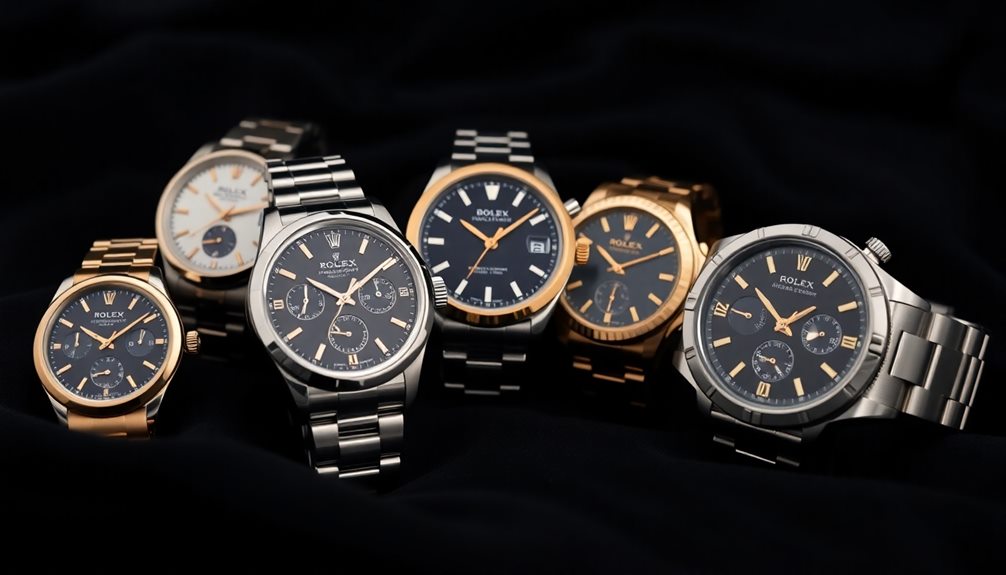
Market analysis shows you'll find the strongest price stability in brands that consistently outperform inflation, with Rolex, Patek Philippe, and Audemars Piguet leading the pack based on auction data from the past decade.
You'll notice these brands maintain their value primarily due to controlled production numbers and overwhelming demand, creating a seller's market even during economic downturns.
Your investment potential is further supported by luxury watches' historical performance as a hedge against market volatility, particularly in times of economic uncertainty.
Historical Price Performance Data
Looking back at decades of pricing data, luxury watch investments have shown remarkable stability compared to other collectible assets.
You'll find that certain luxury timepieces have consistently outperformed traditional investment vehicles, with some models appreciating by 5-15% annually.
Rolex's Daytona and Patek Philippe's Nautilus stand out as prime examples, having multiplied their original retail prices several times over within the past 20 years.
Watch price performance data from auction houses and private sales reveals three distinct patterns:
- Vintage Rolex sports models have appreciated by an average of 250% between 2000 and 2020, with rare references showing even stronger growth.
- Patek Philippe complications have maintained a steady 8-12% annual appreciation rate since the 1990s, particularly for perpetual calendar models.
- Audemars Piguet Royal Oak models have seen a 300% increase in market value over the past decade, with limited editions performing exceptionally well.
These historical trends demonstrate that specific models from prestigious manufacturers don't just retain their value—they've become increasingly sought-after investment pieces in the luxury goods market.
Supply Vs Demand Factors
A watch's price stability hinges heavily on the delicate balance between production volumes and collector demand. You'll find that luxury brands like Rolex and Patek Philippe deliberately limit their annual production to maintain scarcity, which helps preserve their watches' value over time.
When you're evaluating a watch's potential to hold value, consider these key supply factors: annual production numbers, limited edition releases, and discontinued models. Brands that flood the market with numerous variations typically see their watches depreciate faster. For instance, you'll notice that mass-produced fashion watches rarely retain their initial price.
The demand side is equally significant. You should pay attention to factors like brand heritage, complications, and current market trends. Watches from established manufacturers with storied histories tend to command stronger demand.
Additionally, certain complications, such as perpetual calendars or minute repeaters, attract serious collectors who'll pay premium prices. Current market dynamics also affect value retention. You'll want to track emerging collector preferences, which can shift between vintage pieces, modern sports watches, or specific complications depending on prevailing trends in the luxury watch market.
Economic Impact Analysis
The global economic climate plays a direct role in how watch investments perform. When you're analyzing the economic impact on luxury timepieces, you'll notice that certain brands consistently maintain their value even during market downturns. Understanding these economic patterns can help you make informed decisions about which watches to invest in for long-term value retention.
Market data shows that luxury watches often act as hedge investments during economic uncertainty. You'll find that brands like Rolex, Patek Philippe, and Audemars Piguet have demonstrated remarkable resilience during financial crises. This stability stems from their limited production numbers and enduring market demand.
Key economic factors that influence watch values include:
- Currency fluctuations – Strong currencies can affect international buying power and global market prices
- Regional economic growth – Emerging markets often drive demand for luxury timepieces
- Investment alternative trends – When traditional investments become volatile, collectors often turn to watches as stable assets
You'll want to monitor these economic indicators closely, as they can signal potential shifts in the watch market. Historical data suggests that prestigious brands with controlled production maintain their value better during economic downturns compared to mass-produced alternatives.
Top Watch Investment Strategies
Successful watch investing requires three fundamental strategies to maximize potential returns.
First, you'll need to focus on prestigious brands with proven track records of value retention, such as Rolex, Patek Philippe, and Audemars Piguet. These manufacturers consistently demonstrate strong performance in both primary and secondary markets.
Second, you should target limited edition or discontinued models, as their scarcity typically drives price appreciation. Pay special attention to watches with unique complications, historical significance, or those produced in small quantities. You'll find that pieces like the Patek Philippe Nautilus or specific vintage Rolex Daytonas often outperform standard production models.
Third, you must maintain your timepieces in excellent condition to preserve their value. This includes keeping all original packaging, papers, and accessories, while following proper maintenance schedules.
You'll want to service your watches through authorized dealers and store them in appropriate conditions. Consider factors like humidity control and proper storage solutions.
Additionally, document any service history and keep detailed records of authentication certificates, as these greatly impact resale value when you're ready to liquidate your investment.
Frequently Asked Questions
How Do Insurance Companies Determine the Value of Luxury Watches?
Insurance companies will assess your luxury watch's value through professional appraisals, market research, sales records, brand reputation, condition, documentation, and authenticity verification. They'll also consider recent auction prices and collector demand.
Can Water Damage Permanently Affect a Watch's Resale Value?
Yes, water damage can dramatically reduce your watch's resale value, even after repairs. You'll find that moisture damage often leaves lasting issues like corrosion, dial staining, or movement problems that buyers won't overlook.
Do Watch Boxes and Papers Affect Value Differently Across Different Brands?
You'll find box and papers matter most for luxury brands like Rolex and Patek Philippe, where they can add 15-30% to value. For mid-tier watches, they're less vital but still boost resale by 5-10%.
Which Watch Complications Are Least Likely to Maintain Their Value?
You'll find that annual calendars, GMT functions, and moon phases typically lose value faster. Date complications are common and don't add much value, while chronographs and perpetual calendars tend to hold better.
How Do Geopolitical Events Impact Luxury Watch Market Prices?
You'll notice that wars, economic sanctions, and political instability can rapidly shift luxury watch prices by affecting supply chains, currency values, and wealthy buyers' confidence in specific markets or regions.
In Summary
You'll find that luxury watch investments require careful evaluation of brand reputation, historical performance, and market dynamics. While Rolex, Patek Philippe, and Audemars Piguet consistently lead in value retention, you're also wise to take into account limited editions and entry-level luxury pieces from established brands. Remember that condition, authenticity documentation, and timing your purchase can greatly impact your watch's future value.
As a professional trainer and a gadget lover, I’ve spent a lot of money and time buying wearable activity trackers, smartwatches, and gadgets, and checking them out. My site is focused on helping you with your activity tracking and smart technology journey. I try to provide the most helpful updated content on this subject. Hopefully, you will love my blogs and be a regular around here.



